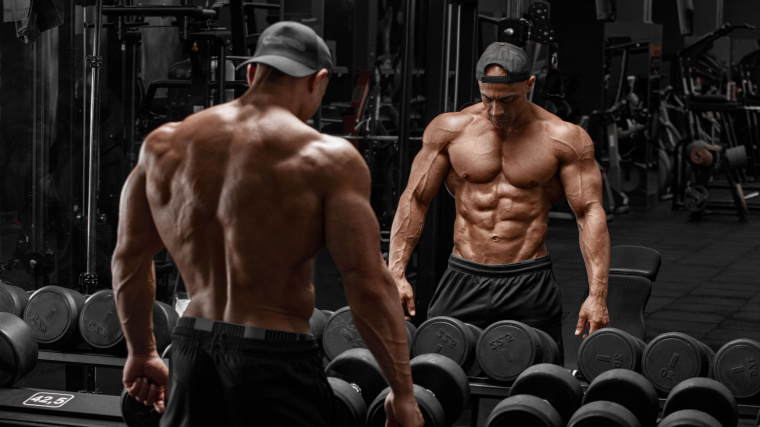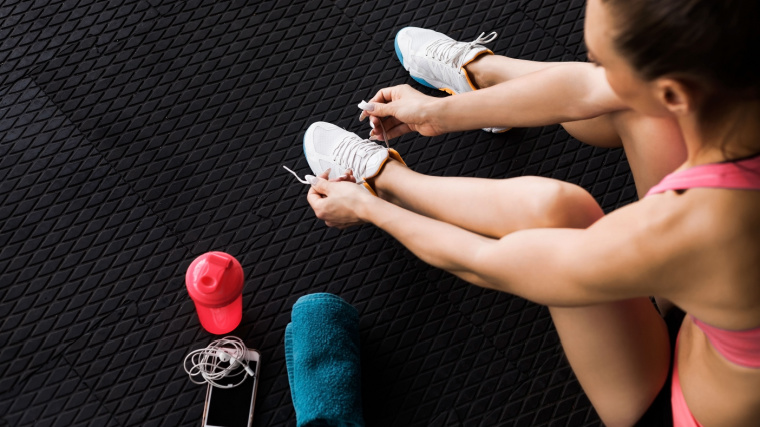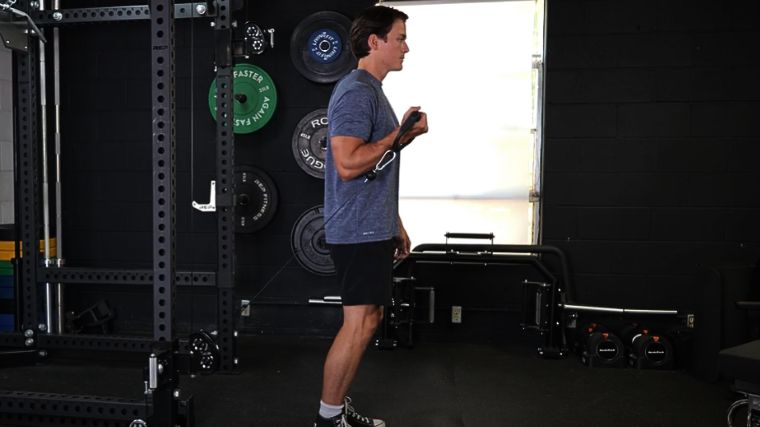Muscle Insider
New member
If you lift weights: Have you ever considered that the vast majority of time during your “workout” is spent sitting on your butt doing nothing at all? Think about it — five good reps in the back squat might take 30 seconds. Afterward, you plop down and rest for several minutes. There’s a lot of downtime during strength...
The post Do These 5 Things Between Sets to Build More Muscle and Burn More Fat appeared first on BarBend.
If you lift weights: Have you ever considered that the vast majority of time during your “workout” is spent sitting on your butt doing nothing at all? Think about it — five good reps in the back squat might take 30 seconds. Afterward, you plop down and rest for several minutes.
There’s a lot of downtime during strength training. You need to take a breather and let your muscles recover from the last set. But is it best to use your time between sets to pop open your phone for a thumb workout or to stare blankly at a wall, letting your brain massage itself to molasses?
 Credit: Nikolas_jkd / Shutterstock
Credit: Nikolas_jkd / Shutterstock
Not really. You can employ a few techniques between sets and enhance the quality of both the workout you’re performing and the hypertrophy (or fat loss) results you’ll glean from it. Here are five things you can do between sets to build more muscle or burn more fat:
Editor’s Note: The content on BarBend is meant to be informative in nature, but it should not be taken as medical advice. When starting a new training regimen and/or diet, it is always a good idea to consult with a trusted medical professional. We are not a medical resource. The opinions and articles on this site are not intended for use as diagnosis, prevention, and/or treatment of health problems. They are not substitutes for consulting a qualified medical professional.
5 Things To Do Between Sets
1. Stay Off Your Phone
After a hard set of squats, deadlifts, rows, or whatever you’re doing, you might habitually reach for your smartphone as it calls to you like the One Ring around Frodo Baggins’ neck. However, you should try to stay off your smartphone between sets as much as possible to maximize your performance in the gym.
The scientific research on this is pretty clear. One study from 2021 measured the effects of smartphone usage (browsing social media) and argued that:
 Credit: OlegMemo / Shutterstock
Credit: OlegMemo / Shutterstock
[Read More: What You Need to Know About How to Build Muscle]
“Exposure to social network apps led participants toward increased perception of mental fatigue.” (1) They also noted some subjects experienced a higher internal RPE, meaning that their weights literally felt heavier than they were.
One caveat to this data is that the study exposed participants to 30 minutes of social media usage prior to their workout, rather than interspersed throughout. That said, dancing with the algorithm between sets probably isn’t doing your performance any favors.
2. Inter-Set Stretching
The science behind muscle hypertrophy hasn’t evolved all that much in recent years. The advice you first heard in high school gym class — lift heavy weights, eat hearty — still mostly holds up.
But there’s finally some new, exciting research coming out that may change how you approach your bodybuilding workouts. A growing body of research is coming out in favor of stretching a muscle during (or between) sets in order to encourage growth.
 Credit: Gerain0812 / Shutterstock
Credit: Gerain0812 / Shutterstock
[Read More: How to Gain Muscle — A Guide to Eating for Mass]
Among bodybuilders, this intensity technique is called “long-length partial training”. But you can apply the same logic to your rest periods by performing some static stretching of the muscle you just finished using.
So, how should you apply inter-set stretching to your workouts? It’s pretty simple. After you finish performing a set of any (preferably single-joint isolation) exercise, put the weights down and stretch the muscle you just worked. For example, after a set of dumbbell flyes, stand up and use a firm structure to stretch your chest muscles for 30 to 45 seconds.
3. Take a Walk
Now, don’t get it twisted — walking away from a station or piece of equipment without any indication that you’re using it is bad gym etiquette (seriously, at least mark your territory with a towel or water bottle). That said, sitting on your bum burns fewer calories than walking, and if you’re in a calorie deficit trying to lose weight fast, every calorie counts.
So, between sets, try taking a quick but leisurely stroll around your gym floor instead of sitting idly. The average casual walking pace is about 100 steps per minute. Most of the time during a lifting workout, you should rest between 2 and 3 minutes between sets, especially if you do a lot of compound exercises.
 Credit: Jyliana / Shutterstock
Credit: Jyliana / Shutterstock
[Read More: Try These 20-Minute Muscle-Building Workouts to Make Gains at the Speed of Light]
Add all that walking up over the course of, say, a 15-set upper body exercises, and you’ve accumulated anywhere from 2,500 to 4,000 extra steps. That’s a good chunk of energy burnt that you wouldn’t even notice.
There’s a pretty causal relationship between number of daily steps and all-cause mortality, too. (5) Walking more can improve your general health and mood. In the gym, you can use that time to scout and see if your next exercise station is occupied, to clear your head, or even regulate your breathing. Burning extra calories is the icing on the cake.
4. Mentally Visualize
Like Luke Skywalker in the trenches of the Death Star, you should make an effort to tap into the powerful reservoir of mental visualization. This isn’t pseudoscience or mumbo-jumbo; there’s been plenty of research on the real-world benefits of imagining yourself doing something successfully before you actually do it.
 Credit: Olya Humeniuk / Shutterstock
Credit: Olya Humeniuk / Shutterstock
[Read More: Are There Foods That Burn Fat? The Science Behind the Weight Loss Claim]
5. Train Other Muscles
This one is more obvious than the others, but it bears repeating. Supersets, or performing two separate exercises back-to-back with no rest, are an awesome way to save time in the gym while still making gains. (8)
But, in fairness, some supersets are extremely exhausting (think squats paired with, like, a different squat variation…). Others, though, could be a productive use of your downtime in the gym, particularly if you opt to train muscles that are far away from the target muscle.

[Read More: How To Lose Fat and Gain Muscle, According to Science]
Performing “small” movements while resting after a “big” exercise can help you bring up lagging body parts or weak points in your physique. Here are a few examples that might suit you:
[*]Romanian Deadlift + Barbell Shrug
[*]Biceps Curl + Calf Raise
[*]Cable Crunch + Barbell Wrist Curl
[*]Seated Dumbbell Overhead Press + Plank
This approach is a more demanding use of your time than the others on this list. If you want to do some “catch-up” work on certain overlooked muscles while you rest, aim for moves that are:
[*]Convenient to access without hogging multiple pieces of equipment
[*]Have simple techniques that don’t require too much thought, and
[*]Don’t involve the muscle you just finished working whatsoever
Your Takeaways
The time you spend resting between sets is important. It’s how you can go through set after set of grueling, high-intensity weight lifting. But that doesn’t necessarily mean you need to sit idly, scrolling through your phone until your brain oozes out of your ears.
More Training Content
References
[*]Gantois, P., Lima-Júnior, D., Fortes, L. S., Batista, G. R., Nakamura, F. Y., & Fonseca, F. S. (2021). Mental Fatigue From Smartphone Use Reduces Volume-Load in Resistance Training: A Randomized, Single-Blinded Cross-Over Study. Perceptual and motor skills, 128(4), 1640–1659.
[*]Nakamura M, Ikezu H, Sato S, Yahata K, Kiyono R, Yoshida R, Takeuchi K, Nunes JP. Effects of Adding Inter-Set Static Stretching to Flywheel Resistance Training on Flexibility, Muscular Strength, and Regional Hypertrophy in Young Men. International Journal of Environmental Research and Public Health. 2021; 18(7):3770.
[*]Schoenfeld BJ, Wackerhage H, De Souza E. Inter-set stretch: A potential time-efficient strategy for enhancing skeletal muscle adaptations. Front Sports Act Living. 2022 Nov 15;4:1035190. doi: 10.3389/fspor.2022.1035190. PMID: 36457663; PMCID: PMC9706104.
[*]Van Every DW, Coleman M, Rosa A, Zambrano H, Plotkin D, Torres X, Mercado M, De Souza EO, Alto A, Oberlin DJ, Vigotsky AD, Schoenfeld BJ. Loaded inter-set stretch may selectively enhance muscular adaptations of the plantar flexors. PLoS One. 2022 Sep 1;17(9):e0273451. doi: 10.1371/journal.pone.0273451. PMID: 36048793; PMCID: PMC9436038.
[*]Jayedi, A., Gohari, A., & Shab-Bidar, S. (2022). Daily Step Count and All-Cause Mortality: A Dose-Response Meta-analysis of Prospective Cohort Studies. Sports medicine (Auckland, N.Z.), 52(1), 89–99.
[*](2013). Attentional focus and motor learning: A review of 15 years. International Review of Sport and Exercise Psychology. 6. 77-104. 10.1080/1750984X.2012.723728.
[*]Schoenfeld, B. J., Vigotsky, A., Contreras, B., Golden, S., Alto, A., Larson, R., Winkelman, N., & Paoli, A. (2018). Differential effects of attentional focus strategies during long-term resistance training. European journal of sport science, 18(5), 705–712.
[*]Iversen, V.M., Norum, M., Schoenfeld, B.J. et al. No Time to Lift? Designing Time-Efficient Training Programs for Strength and Hypertrophy: A Narrative Review. Sports Med 51, 2079–2095 (2021).
Featured Image: Nikolas_jkd / Shutterstock
The post Do These 5 Things Between Sets to Build More Muscle and Burn More Fat appeared first on BarBend.
Click here to view the article.
The post Do These 5 Things Between Sets to Build More Muscle and Burn More Fat appeared first on BarBend.
If you lift weights: Have you ever considered that the vast majority of time during your “workout” is spent sitting on your butt doing nothing at all? Think about it — five good reps in the back squat might take 30 seconds. Afterward, you plop down and rest for several minutes.
There’s a lot of downtime during strength training. You need to take a breather and let your muscles recover from the last set. But is it best to use your time between sets to pop open your phone for a thumb workout or to stare blankly at a wall, letting your brain massage itself to molasses?

Not really. You can employ a few techniques between sets and enhance the quality of both the workout you’re performing and the hypertrophy (or fat loss) results you’ll glean from it. Here are five things you can do between sets to build more muscle or burn more fat:
Editor’s Note: The content on BarBend is meant to be informative in nature, but it should not be taken as medical advice. When starting a new training regimen and/or diet, it is always a good idea to consult with a trusted medical professional. We are not a medical resource. The opinions and articles on this site are not intended for use as diagnosis, prevention, and/or treatment of health problems. They are not substitutes for consulting a qualified medical professional.
5 Things To Do Between Sets
- Stay Off Your Phone
- Inter-Set Stretching
- Take a Walk
- Mental Visualization
- Train Other Muscles
1. Stay Off Your Phone
After a hard set of squats, deadlifts, rows, or whatever you’re doing, you might habitually reach for your smartphone as it calls to you like the One Ring around Frodo Baggins’ neck. However, you should try to stay off your smartphone between sets as much as possible to maximize your performance in the gym.
The scientific research on this is pretty clear. One study from 2021 measured the effects of smartphone usage (browsing social media) and argued that:

[Read More: What You Need to Know About How to Build Muscle]
“Exposure to social network apps led participants toward increased perception of mental fatigue.” (1) They also noted some subjects experienced a higher internal RPE, meaning that their weights literally felt heavier than they were.
One caveat to this data is that the study exposed participants to 30 minutes of social media usage prior to their workout, rather than interspersed throughout. That said, dancing with the algorithm between sets probably isn’t doing your performance any favors.
2. Inter-Set Stretching
The science behind muscle hypertrophy hasn’t evolved all that much in recent years. The advice you first heard in high school gym class — lift heavy weights, eat hearty — still mostly holds up.
But there’s finally some new, exciting research coming out that may change how you approach your bodybuilding workouts. A growing body of research is coming out in favor of stretching a muscle during (or between) sets in order to encourage growth.

[Read More: How to Gain Muscle — A Guide to Eating for Mass]
Among bodybuilders, this intensity technique is called “long-length partial training”. But you can apply the same logic to your rest periods by performing some static stretching of the muscle you just finished using.
- “The results indicate that adding inter-set stretching to resistance training may provide large gains in flexibility and slight benefits to muscular strength,” says one 2021 paper. (2) Though these authors found no clear benefit to muscle growth.
- “Some evidence suggests that inter-set stretching may in fact enhance hypertrophic adaptations,” claims a study published in 2022. The authors also regarded it as a time-efficient way of making your workouts more productive. (3)
- A different 2022 paper studied loaded stretching of the calf muscles between sets and observed notable increases in muscle thickness. (4)
So, how should you apply inter-set stretching to your workouts? It’s pretty simple. After you finish performing a set of any (preferably single-joint isolation) exercise, put the weights down and stretch the muscle you just worked. For example, after a set of dumbbell flyes, stand up and use a firm structure to stretch your chest muscles for 30 to 45 seconds.
3. Take a Walk
Now, don’t get it twisted — walking away from a station or piece of equipment without any indication that you’re using it is bad gym etiquette (seriously, at least mark your territory with a towel or water bottle). That said, sitting on your bum burns fewer calories than walking, and if you’re in a calorie deficit trying to lose weight fast, every calorie counts.
So, between sets, try taking a quick but leisurely stroll around your gym floor instead of sitting idly. The average casual walking pace is about 100 steps per minute. Most of the time during a lifting workout, you should rest between 2 and 3 minutes between sets, especially if you do a lot of compound exercises.

[Read More: Try These 20-Minute Muscle-Building Workouts to Make Gains at the Speed of Light]
Add all that walking up over the course of, say, a 15-set upper body exercises, and you’ve accumulated anywhere from 2,500 to 4,000 extra steps. That’s a good chunk of energy burnt that you wouldn’t even notice.
There’s a pretty causal relationship between number of daily steps and all-cause mortality, too. (5) Walking more can improve your general health and mood. In the gym, you can use that time to scout and see if your next exercise station is occupied, to clear your head, or even regulate your breathing. Burning extra calories is the icing on the cake.
4. Mentally Visualize
Like Luke Skywalker in the trenches of the Death Star, you should make an effort to tap into the powerful reservoir of mental visualization. This isn’t pseudoscience or mumbo-jumbo; there’s been plenty of research on the real-world benefits of imagining yourself doing something successfully before you actually do it.

[Read More: Are There Foods That Burn Fat? The Science Behind the Weight Loss Claim]
- Years of research on what’s called “attentional focus” (as in, actively visualizing the task at hand) have shown that doing so can improve your rate of skill acquisition and technical performance. (6)
- More specifically to weight lifting, visualizing the mind-muscle connection has some legitimate basis for improving hypertrophy rates. (7)
5. Train Other Muscles
This one is more obvious than the others, but it bears repeating. Supersets, or performing two separate exercises back-to-back with no rest, are an awesome way to save time in the gym while still making gains. (8)
But, in fairness, some supersets are extremely exhausting (think squats paired with, like, a different squat variation…). Others, though, could be a productive use of your downtime in the gym, particularly if you opt to train muscles that are far away from the target muscle.

[Read More: How To Lose Fat and Gain Muscle, According to Science]
Performing “small” movements while resting after a “big” exercise can help you bring up lagging body parts or weak points in your physique. Here are a few examples that might suit you:
[*]Romanian Deadlift + Barbell Shrug
[*]Biceps Curl + Calf Raise
[*]Cable Crunch + Barbell Wrist Curl
[*]Seated Dumbbell Overhead Press + Plank
This approach is a more demanding use of your time than the others on this list. If you want to do some “catch-up” work on certain overlooked muscles while you rest, aim for moves that are:
[*]Convenient to access without hogging multiple pieces of equipment
[*]Have simple techniques that don’t require too much thought, and
[*]Don’t involve the muscle you just finished working whatsoever
Your Takeaways
The time you spend resting between sets is important. It’s how you can go through set after set of grueling, high-intensity weight lifting. But that doesn’t necessarily mean you need to sit idly, scrolling through your phone until your brain oozes out of your ears.
- You can perform certain activities while resting between sets to enhance the quality of your workouts.
- Inter-set stretching, visualizing the next set, or even taking a brief walk are all ways to use your in-the-gym downtime productively.
- Anything you do between sets should not come at the expense of the quality of those sets. If you genuinely need a breather without interruption after a hard set of squats, deadlifts, or rows, take it.
- These small behaviors can add up to a tangible impact on your performance over time, but you shouldn’t consider them more important than your actual workout.
More Training Content
- Is 10,000 the Magic Number? The Science Behind Taking 10,000 Steps a Day
- What To Eat After Your Workout
- What Is Tabata Training? How To Get Fitter in Just Four Minutes
References
[*]Gantois, P., Lima-Júnior, D., Fortes, L. S., Batista, G. R., Nakamura, F. Y., & Fonseca, F. S. (2021). Mental Fatigue From Smartphone Use Reduces Volume-Load in Resistance Training: A Randomized, Single-Blinded Cross-Over Study. Perceptual and motor skills, 128(4), 1640–1659.
[*]Nakamura M, Ikezu H, Sato S, Yahata K, Kiyono R, Yoshida R, Takeuchi K, Nunes JP. Effects of Adding Inter-Set Static Stretching to Flywheel Resistance Training on Flexibility, Muscular Strength, and Regional Hypertrophy in Young Men. International Journal of Environmental Research and Public Health. 2021; 18(7):3770.
[*]Schoenfeld BJ, Wackerhage H, De Souza E. Inter-set stretch: A potential time-efficient strategy for enhancing skeletal muscle adaptations. Front Sports Act Living. 2022 Nov 15;4:1035190. doi: 10.3389/fspor.2022.1035190. PMID: 36457663; PMCID: PMC9706104.
[*]Van Every DW, Coleman M, Rosa A, Zambrano H, Plotkin D, Torres X, Mercado M, De Souza EO, Alto A, Oberlin DJ, Vigotsky AD, Schoenfeld BJ. Loaded inter-set stretch may selectively enhance muscular adaptations of the plantar flexors. PLoS One. 2022 Sep 1;17(9):e0273451. doi: 10.1371/journal.pone.0273451. PMID: 36048793; PMCID: PMC9436038.
[*]Jayedi, A., Gohari, A., & Shab-Bidar, S. (2022). Daily Step Count and All-Cause Mortality: A Dose-Response Meta-analysis of Prospective Cohort Studies. Sports medicine (Auckland, N.Z.), 52(1), 89–99.
[*](2013). Attentional focus and motor learning: A review of 15 years. International Review of Sport and Exercise Psychology. 6. 77-104. 10.1080/1750984X.2012.723728.
[*]Schoenfeld, B. J., Vigotsky, A., Contreras, B., Golden, S., Alto, A., Larson, R., Winkelman, N., & Paoli, A. (2018). Differential effects of attentional focus strategies during long-term resistance training. European journal of sport science, 18(5), 705–712.
[*]Iversen, V.M., Norum, M., Schoenfeld, B.J. et al. No Time to Lift? Designing Time-Efficient Training Programs for Strength and Hypertrophy: A Narrative Review. Sports Med 51, 2079–2095 (2021).
Featured Image: Nikolas_jkd / Shutterstock
The post Do These 5 Things Between Sets to Build More Muscle and Burn More Fat appeared first on BarBend.
Click here to view the article.




